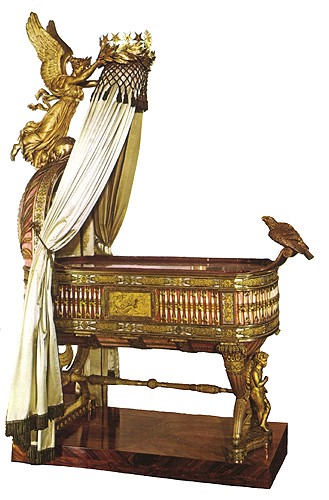On 20 March, 1811, the Empress Marie-Louise gave birth to the heir to the imperial throne, the Roi de Rome, or King of Rome. Two weeks earlier, the Prefect of the Département de la Seine, Frochot, and the Conseil Municipal (Paris town council) had offered on behalf of the Ville de Paris (City of Paris) a cradle fit for the longed-for future emperor. A traditional present for this sort of event, the cradle of the Roi de Rome is remarkable for its extraordinary magnificence. Many artists worked on its creation. The painter Prud'hon made the plans, the bronze- and goldsmiths Thomire and Odiot founded and chased it in gilt silver, the sculptor Roguier modelled the figures. A work of almost unbelievable opulence, the cradle is one of the finest pieces of imperial furniture.
Standing on feet fashioned as crossed horns of plenty fronted by the genii of Strength and Justice, the boat of the cradle is decorated with mother-of-pearl balusters set on a background of nacarat velvet spotted with gilt bees. The decorative programme was dictated by symbolism of the empire. At the head of the cradle there is a shield bearing the Emperor's cypher, encircled by palms and laurels. Above, Winged Victor, soaring over the world, bears a double crown of stars and laurels, from which hang the drapes. At the other end, an Aiglon (or eaglet) appears to be about to take flight towards this allegory of triumph and immortality, in the centre of which blazes Napoleon's star. The glory of the father watches over the son, whilst at the same time calling him the same destiny. Two bas-reliefs on the sides of the cradle boat complete the sumptuous decoration, evoking the union of Paris and Rome, the two principal cities of the Empire, linked by the birth of the young king. On one side, Mercury lays the baby in the arms of a personification of the Seine river; on the other, the figure of the Tiber contemplates the new star which has just risen.
It was in this formal presentation cradle that the baby was laid, the day of his birth. Other, much more run-of-the-mill cradles provided for his everyday sleeping arrangements, one of these can be seen at the Musée du château de Fontainebleau. As for the cradle given by the Ville de Paris, it was taken to Austria in 1814 on the request of Marie Louise. So if you want to stand in awe before it, you have to go to Vienna.
Karine Huguenaud (tr. P.H.)
February 2004
The Roi de Rome’s cradle

- Date :
- 1811
- Technique :
- Silver-gilt, mother-of-pearl, velvet, silk and tulle
- Dimensions :
- H = 2.16 m
- Place held :
- Vienne, Kunsthistorisches Museum, Weltliche Schatzkammer
- Photo credit :
- © Fondation Napoléon

